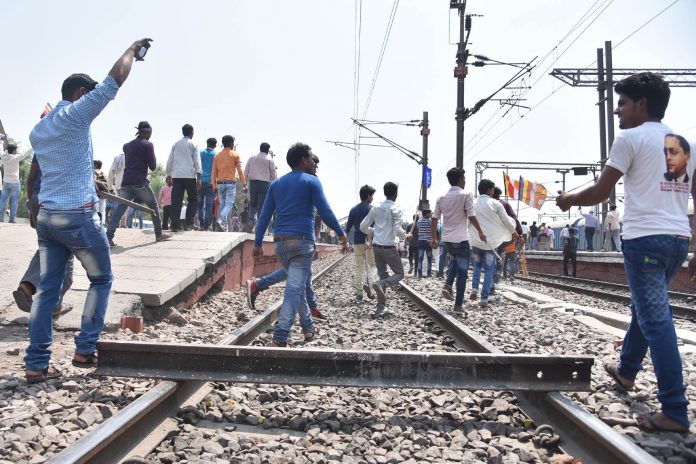
By Amulya Ganguli
The Bharatiya Janata Party (BJP) owes much of its woes to the reluctance of its core constituency of urban, upper caste, conservative, anti-minority, middle class supporters to accept Prime Minister Narendra Modi’s “sabka saath, sabka vikas” mantra of development for all.
They may have no objections to “vikas”, but the idea of including everyone in its fold is anathema to them. So, if they see a Dalit having fared well enough in life to own a horse and ride it, he has to be killed as in Gujarat’s Bhavnagar district. Or, if a Dalit groom wants to take out a “baraat” (marriage procession) through his village in Uttar Pradesh, the upper caste residents will not allow it.
Killing is the usual option for the saffron rank and file to eliminate those whose conduct violates the Hindutva fads and fetishes.
Hence, anyone suspected of eating beef or who believes in inter-faith romance is either beaten up or done away with. Moreover, the Hindutva storm-troopers are so sure of the righteousness of their cause that they are not deterred by the presence of video cameras when they engage in their lawless acts.
In the 93 years since the formation of the Rashtriya Swayamsevak Sangh (RSS) and 67 years of the Jan Sangh-BJP, Muslims were their sole targets. The Dalits were largely ignored because, till recently, they were not assertive enough to annoy the saffron brigade.
The BJP even toys with the idea of winning them over for use as vote banks. It is trying to do so by occasionally paying obeisance to the Dalit icon, B.R. Ambedkar, and choosing a Dalit as the President.
But much of this placatory signalling is probably regarded as tokenism by the Dalits while for the members of the Brahmin-Bania party, these gestures mean nothing where their caste bias is concerned.
Hence, the flogging of four Dalit youths by “gau rakshaks” (cow protectors) in Una, Gujarat, the hounding to death of Dalit scholar Rohith Vemula in Hyderabad and the prolonged incarceration of the firebrand Dalit youth leader, Chandrashekhar Azad “Ravan”, by Uttar Pradesh Chief Minister Yogi Adityanath.
It is not surprising that against the background of the saffron targeting of Dalits, the recent Supreme Court judgment purportedly diluting the act relating to Atrocities against the Dalits and Adivasis acted as the spark that lit the fires of mob violence during a bandh called by Dalit outfits.
What is odd, however, is that the BJP (and the RSS) hadn’t kept this possibility of a sudden outburst in mind. It is no secret that these Hindutva organisations care little about the Muslims being alienated because they are aware that the minorities, whether Muslims or Christians, will not vote for the BJP except in very small numbers or when there is some kind of a wave as in 2014.
But antagonising the Dalits, who constitute 16.6 per cent of the population, is a politically self-defeating exercise, not least because if this percentage is added to 14.2 per cent of the Muslims, it will mean that the BJP is risking losing the support of nearly a third of the country’s population.
Taken together with the Christians (2.3 per cent) and the liberal Hindus as well as those who have been disenchanted by Modi’s inability to keep his promise on job creation, the number of those who are opposed to the BJP has to be substantial. The portents, therefore, for the party’s prospects in 2019 cannot be very bright.
The scene is made more complicated for the BJP by the occasional criticism of the policy of reservations by the RSS. The Brahminical motive for opposing the quota system is driven not so much by an urge for placing merit above caste as by the sense of outrage in Hindutva circles at the possibility of Dalits rising to high places in educational and bureaucratic institutions at the expense of the upper castes.
It is obvious that Modi had taken on a near-impossible task of selling his plan for all-round development irrespective of caste and creed to his party’s core elements, although as a former RSS “pracharak” (preacher), he must have been acutely aware of the resistance which they were likely to offer.
He probably hoped that success in his efforts will boost the economy and create enough euphoria among all sections to stymie any serious opposition. But the failure to usher in the promised “achhey din” (good days) has been his bane not only because it has emboldened the opposition, but even more so because a stagnating economy is ideal breeding ground for disaffection even among friends like the saffron activists.
Not surprisingly, the Hindutva militants lost no time to take revenge for the Dalit-sponsored bandh to burn down the houses of a Dalit MLA of the BJP and a former Congress MLA who is a Dalit in Rajasthan.

